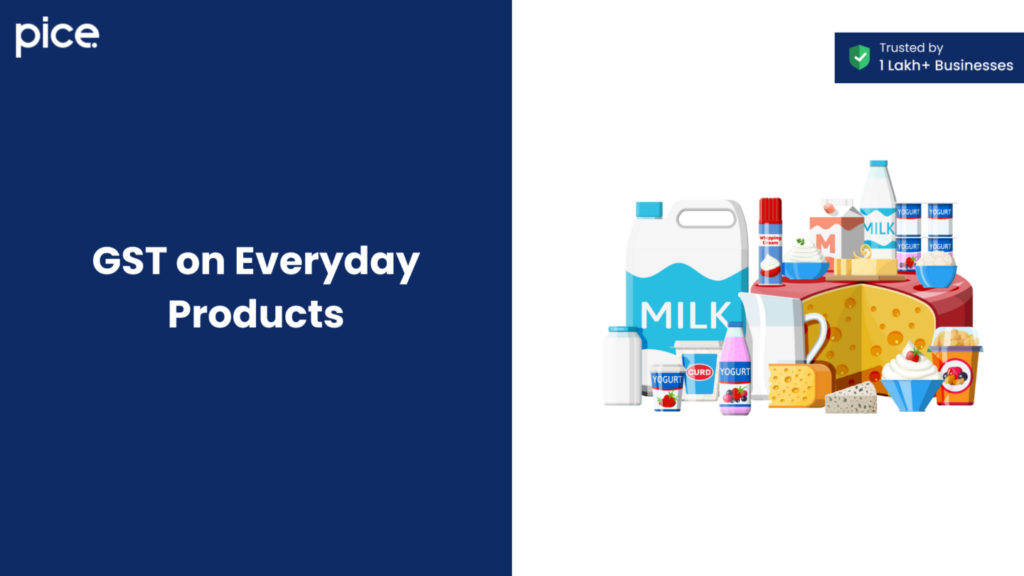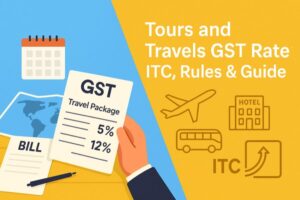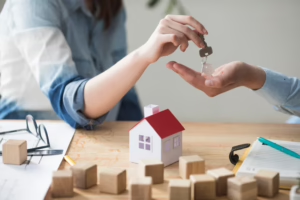What Is the Impact of GST on a Common Man?
- 10 Sep 24
- 12 mins

What Is the Impact of GST on a Common Man?
Key Takeaways
- GST has unified the indirect tax system, simplifying the taxation process across India.
- Essential goods consumed by the common man are taxed at lower rates, while luxury items have higher taxes.
- Services like banking, telecom, and hospitality have become more expensive under GST, while essential goods remain affordable.
- The GST regime has reduced the overall tax burden for many, but it has increased compliance requirements for businesses.
- Although GST aims to reduce inflation, some sectors and services have seen a rise in costs, impacting daily expenses.
On July 1, 2017, the implementation of Goods and Services Tax (GST) in India streamlined and unified the indirect tax system in the national market. The GST effects on middle and lower-middle-class backgrounds are felt through changes in the cost of daily essential products and services. When the cost of everyday items drops, it reflects a positive economic shift. However, if there is a rise in inflation rates, it causes dissatisfaction among the public.
Therefore, let us go through this blog to understand the impact of GST on the common man and how it affects the prices of daily essentials.
Understanding GST
Also known as 'One Nation, One Tax', GST is one of the types of indirect taxes applicable to almost all goods and services. It substituted many taxes that were hitherto being levied by the Central as well as the State Governments. This single tax has contributed towards the reduction of the cost of production and the formation of a single market across the states.
💡If you want to pay your GST with Credit Card, then download Pice Business Payment App. Pice is the one stop app for all paying all your business expenses.
GST has been structured with various tax slabs for luxury goods that are usually purchased by the affluent and are subjected to higher taxes. While the basic commodities that are consumed by the common man are subjected to lower taxes. In India, the GST slabs are set at 0%, 5%, 12%, 18% and 28%.
Here are the individuals and businesses required to pay GST:
- Individuals or businesses managing inter-state supplies of goods and services
- Businesses with annual turnover over ₹20 lakhs, except for those dealing in exempt goods and services
- Input service distributors
- Anyone registered under VAT, central excise duties or service tax laws needs to comply with GST
- Casual and non-resident taxable person
- E-commerce operators
- Foreign companies who supply online information, databases or other digital services internationally
GST on Everyday Products

Here is a table showcasing the GST rates on different daily-use products:
| Tax Rates | Products |
| 0% | Salt, curd, educational services, fresh vegetables, prasad, eggs, unpacked foodgrains, unpacked paneer, children’s books, besan, lassi, natural honey, health services, sanitary products, palmyra jaggery, phool bhari jhadoo, milk, etc. |
| 5% | Tea, roasted coffee beans, fabric, packed paneer, skimmed milk powder, sugar, domestic LPG, edible oils, cashew nuts, matting and floor covering, raisin, PDS kerosene, apparels (< ₹1000), footwear (< ₹500), Indian sweets, agarbatti, spices, coffee, tobacco leaves, etc. |
| 12% | Ghee, butter, processed food, fruit juice, mobiles, computers, almonds, packed coconut water, preparations of vegetables, fruits, nuts or other parts of plants, chutney, jam, umbrella, etc. |
| 18% | Toothpaste, soap, toiletries, industrial intermediaries, capital goods, soups, pasta, ice cream, cornflakes, computers, printers, pharmaceutical products, etc. |
| 28% | Small cars, luxury cars, high-end motorcycles, aerated drinks, consumer durables such as fridges, washing machines, and AC, cigarettes, make-up products, haircare products, etc. |
Services Covered Under GST
Here is a list of different services which fall under GST:
- Professional services
- Contract services
- IT services
- Transport services
- Courier services
- Consultancy services
While GST has led to lower costs for many daily-use products, it has not had the same effect on services commonly used by households. Service providers like financial and telecom services have become slightly more expensive under the new tax regime. Even transportation services have seen a price change, varying based on the travel class.
Impact of the GST Regime on the Common Man
The impact of GST on the common man has led to noticeable changes in the prices of various goods and services. These changes are still being adjusted to meet individual needs. Here are some examples:
- Household Expenses
Under the GST regime, essential food items are taxed at the lowest rates, between 0% and 5%, and are unlikely to see a price increase. Other Fast-Moving Consumer Goods (FMCG) like toiletries, medicines and packaged foods might become more affordable. However, services like laundry, telecommunications and beauty salons have become more expensive due to a 3% increase in the tax rate.
- Restaurants
Suppose you ordered a meal worth ₹1,000 at a famous restaurant. Earlier you had to pay a 6% Service Tax and 12.5% VAT, which in turn increased the bill by ₹185. The air-conditioned restaurant under GST now takes a flat 18% tax and hence the tax amount is slightly lower, ₹180. The intervention has had little effect on the food and beverage sub-sector.
- Public Transport
If you often use transport services such as Uber or Ola, you might have realised that the fare charges are slightly lower. This is because GST is charged at 5%, as compared to the previous 6% Service Tax.
- Hotels and Lodging
As for the changes in price slabs, different effects have occurred in the hospitality industry. Earlier, hotel bills came with taxes of about 19% to 25%, inclusive of the state luxury taxes. Under GST, any hotel accommodation that costs more than ₹7,500 per night attracts a tax rate of 28% which has raised the prices drastically. This change has especially impacted hotels such as the Oberoi, ITC, Taj, Leela and so on, which have much higher rates than standard hotels.
- Air Travel
Economy class air travel has seen a slight reduction in taxes, from the earlier 6% Service Tax to 5% under GST. However, business class tickets have become more expensive, with the tax rate increasing from 9% to 12%.
- Real Estate
The impact of GST on real estate varies by state. Previously, indirect taxes like VAT and Service Tax totalled around 5.5%, but under GST, this has increased to 12%. The real estate sector may initially face inflationary pressures that will take time to stabilise. Ready-to-move-in properties with completion certificates remain unaffected by GST.
- Banking and Insurance
Banking services have seen a modest 3% increase in tax rates, from the previous 15% to 18% under GST.
Exemptions Under the GST Regime
Here is a list of common goods that are exempted under the GST regime –
| Types of goods | Examples |
| Natural products | Fresh and pasteurised milk, honey, eggs, cheese, etc. |
| Vegetables | Potatoes, tomatoes, onions, etc. |
| Fruits | Bananas, apples, grapes, etc. |
| Live animals | Cows, asses, goats, sheep, poultry, etc. |
| Fish | Fresh or frozen fish |
| Meat | Fresh and frozen meat of goats, cows, sheep, pigs, horses, etc. |
| Trees and plants | Flowers, roots, bulbs, foliage, etc. |
| Tea, coffee and spices | Turmeric, tea leaves, coffee beans, ginger, etc. |
| Grains | Rice, wheat, barley, oats, barley, etc. |
| Dry fruits | Cashew nuts, walnuts, etc. |
| Seeds | Oil seeds, cereal husks, flower seeds, etc. |
| Water | Tender coconut water, mineral water, etc. |
| Baked goods | Puffed rice, bread, pizza base, etc. |
| Fossil fuels | Electrical energy |
| Fertilisers | Goods and organic manure |
| Beauty products | Bindi, kajal, lipstick, etc. |
| Ornaments | Plastic and glass bangles, etc. |
| Drugs and pharmaceuticals | Human blood, contraceptives, etc. |
| Waste | Municipal waste, sewage sludge, etc. |
| Newsprint | Rupee notes, envelopes, judicial stamp paper, etc. |
| Fabrics | Khadi, raw silk, silkworm cocoon, etc. |
| Printed items | Newspapers, printed books, maps, etc. |
| Pottery | Earthen pots, clay lamps, etc. |
| Hand tools | Spade, hammer, etc. |
Here are some services that are exempted from GST –
| Types of services | Examples |
| Agricultural services | Cultivation, providing farm labour, renting or leasing agricultural machinery, activities related to warehousing, harvesting, and services offered by commission agents or the Agricultural Produce Marketing Committee or Board for the purchase or sale of agricultural produce. |
| Government services | Transportation of people or goods, postal service, services offered to diplomats, services by a foreign diplomat in India, services offered by the RBI, etc. |
| Transportation services | Transportation of passengers by air, transportation of goods by road, rail, water, etc., payment of toll, transportation of goods worth less than ₹1,500, etc. |
| Judicial services | Services provided by an arbitral tribunal, a partnership firm of advocates, or senior advocates to individuals or businesses with a total turnover of up to ₹40 lakhs. |
| Educational services | Mid-day meal scheme, transportation of faculty or students, examination services, etc. |
| Medical services | Services given by ambulances, medical professionals, veterinary doctors, charities, etc. (excluding cosmetic or hair transplant or plastic surgery.) |
| Organisational services | Services given by tour operators for foreign tourists, exhibition organisers for international business exhibitions, etc. |
| Other services | Services provided by GSTN to the Central or State Governments or Union Territories, as well as admission fees for theatres, circuses, sports events, etc., where the charge does not exceed ₹250. |
Positive Effects of GST on the Common Man
The following are the positive impacts of GST on a registered person:
- GST replaced multiple indirect taxations like CST, VAT, services tax, excise, SAD and CAD with a single, integrated tax system.
- With it, calculations are easier now and it gives a clear understanding of the tax paid by buyers when purchasing products.
- The amount of GST payable is based on a company's annual turnover and size, benefiting small and medium enterprises by offering them favourable tax treatment.
- Broadly, the GST has brought down the overall income that is taxable and hence has helped in mobilising more resources for production.
- The implementation of the unified tax system under GST has enhanced goods transportation, making business operations throughout the country better.
- There has been a rise in export volumes since the customs duties on goods have been reduced and the production units are now saving their manufacturing costs with the implementation of GST.
Negative Effects of GST on the Common Man
The following highlights the negative impact of GST on the common man:
- To meet the requirements of GST, proper invoicing and accounting systems should be followed and thus GST accounting software has evolved.
- If the sellers fail to extend the GST benefits to customers and instead make an increase in their profit margin, then the prices of goods may also go up.
- There may be an increase in the inflation rate at the onset of GST, but it might reduce in the future.
- To enhance the consumer benefits of GST, there is a need to check on instances of profiteering.
- Firms have to make GST payments and file returns within the stipulated time, which increases their compliance expenses.
- The filing of GST returns is not as straightforward as it seems and many business owners have to seek the help of a tax consultant.
- While the government is focusing on simplifying the return filing process, it will still take some time before it becomes perfect.
- Large companies with adequate human resources can easily handle the GST processes, but small traders, service providers or new businesses may find it difficult
The Bottom Line
Overall, the introduction of GST has significantly reduced opportunities for black money and corruption, helping to protect the common man's finances in India. The impact of GST on the common man is a blend of benefits and losses. Although GST’s goal is to simplify and make the Indian taxation structure more transparent, its impact on daily expenditures and services is still being fine-tuned.
 By
By 

















